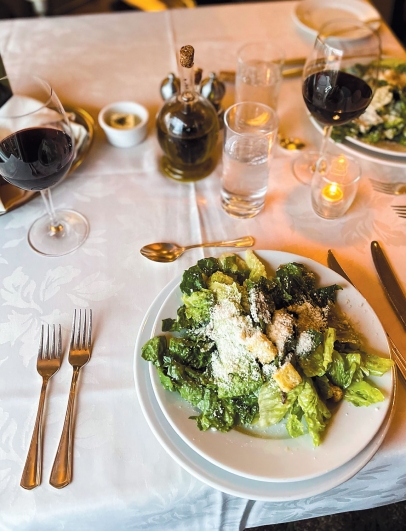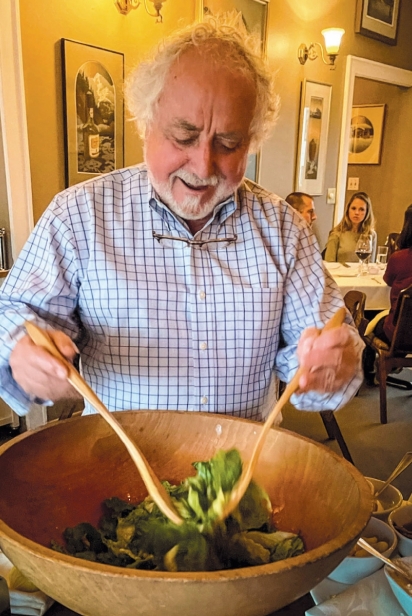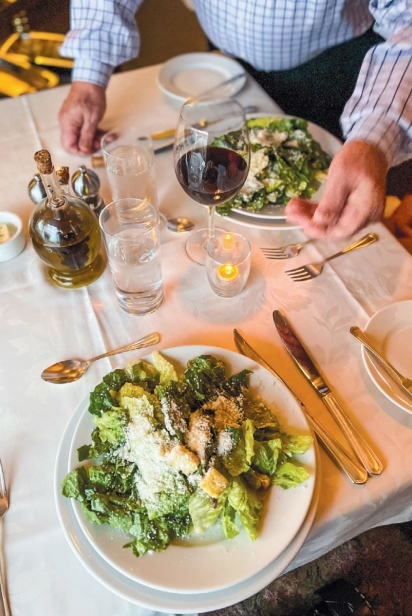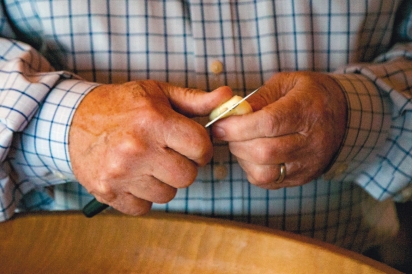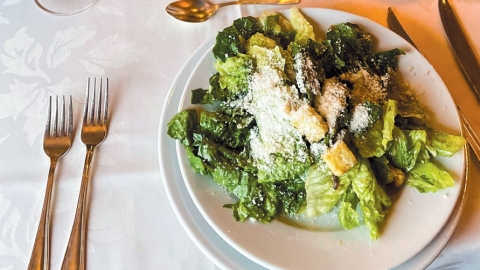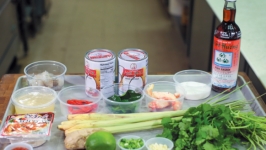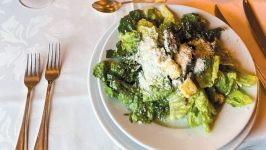Salad Razzle Dazzle
The Makings of The Marx Bros. Café’s Famous Caesar
At The Marx Bros. Café in downtown Anchorage, there’s nothing simple about a Caesar salad.
For 42 years, the starter has been the sole constant on the frequently changing menu, always served tableside with razzle-dazzle showmanship.
It starts with a drizzle of olive oil in a handsome wooden bowl that’s large enough for eight servings. Then soft, aromatic garlic is added, followed by anchovy fillets for natural salt, each mashed into a paste by a fork and spread about until the mixture coats the bottom half of the dish. Next a coddled egg and the juice from half a lemon are swirled and married with tangy balsamic and more oil olive. A tangle of Parmigiano-Reggiano, a large head of torn romaine, and a generous handful of croutons are joined with the mix and are tossed until coated, before the salad is served on chilled plates and topped with freshly ground black pepper. It’s a show that is repeated about 60 times a night in the tiny dining room of the historic 105-year-old cottage.
“It should take about three minutes to make one from start to finish,” said 74-year-old co-owner Van Hale, “but it usually takes longer, because I like to talk to my guests. They always ask questions—about the Caesar, about the business—and I’m happy to stay and answer them.”
While all the servers are trained to make the Caesars, it’s Hale’s passion project—he does the bulk of the orders. It’s something he delights in doing, because this particular iteration was his vision, his signature version of the classic salad.
“It’s very well known,” Hale said of the Van’s Caesar. “Many people come here specifically for it.” Not bad for a restaurant that also boasts a menu with entrées like tea smoked duck and Moroccan mint crusted rack of lamb.
While other restaurants with prized dishes may keep the minute details of the recipes close to the chest, Hale doesn’t. On Saturday mornings, in the winter and spring, the saladsmith invites guests to the café to learn the finer points of making his Caesar.
Guests lucky enough to score a seat (the class always sells out) find themselves tying on their apron and standing around a long table weighed down with a veritable “Twelve Days of Christmas” of ingredients: 12 balsamics, 11 cheeses, ten olive oils, six anchovies, five wines, and four crouton styles.
For Hale it’s not enough that students know how to make a Caesar; they also need to understand how the quality of ingredients changes a recipe.
“It’s to show people that if you buy the best products off the shelf, this is what your salad is going to taste like and if you buy the least desirable off the shelf, this is what your salad is going to taste like,” Hale explained. It’s also a bit of marketing for the restaurant—the ingredients of Hale’s Caesar are for sale at the host stand year-round.
Using the ingredients on the table, the students make four Caesar salads: the Carrs’, the Busch’s, the Original Tijuana, and Van’s. The recipe is the same each time, but the overall quality of the ingredients increases with each remake. The Carrs’, for example, uses some of the better ingredients found at the grocery store of the same name. Van’s, on the other hand, uses the same ingredients as the salads made within Marx Bros., ingredients that Hale has spent a lifetime sourcing.
The class starts with Hale sharing a bit of his history. He began working in the restaurant industry when he was just 13 years old, and has held various positions in the more than 60 years since. At 19, during the Vietnam War, he enlisted in the U.S. Coast Guard and was sent to a school for cooks and bakers in Connecticut, before being stationed on an icebreaker in Washington state and Alaska. He learned a lot in that time, but it wasn’t until after his service, when he worked on the top floor restaurant of a Seattle Hilton, that he first learned how to make Caesar salads.
“I loved it immediately,” Hale said, adding that he enjoyed the theatrics of preparing the dish tableside and having the chance to chitchat with customers.
Eventually, he moved to Anchorage and began managing a funky little Anchorage bar called the Jade Room. In 1977, he met his soon-to-be business partners and together, they started what would be called “The Wednesday Night Gourmet Wine Tasting Society and Volleyball Team Which Now Meets on Sunday.” It was in that capacity that Hale started teaching locals about how to pair food, like a Caesar salad, with wine.
When the Jade Room changed hands, they were asked to leave. Soon after, though, Hale happened to drive by a little house on 3rd Avenue in downtown Anchorage with a lease sign out front. He’d always wanted to run a restaurant in a home—it felt serendipitous.
It wasn’t a particularly easy move from the bar to the house. In fact, it was so clumsy, that it inspired the name: The Marx Bros. Café. The restaurant opened its doors on October 18, 1979 and shortly after, Hale started teaching his weekend classes. Over the years, he’s also taught a standard food and wine class, a wine and cheese of the world class, and a bubbles (think champagnes, bruts, cavas, and other sparkling wines) class, but the Caesar was far and away always the most popular.
After the background, Hale dives into the main course of the lesson: salad making. He discusses the merits of the wooden bowl he uses. Sure, you could use any bowl, but the wooden bowls, he argues, are similar to cast iron for one unique reason.
“The wood bowls, you know, they give you flavors back all the time,” Hale said, adding that he can make about 50,000 salads before the bowl is worn out and needs to be replaced. He makes more than 8,000 Caesars a year, not including the thousands he donates to various charitable causes throughout the year. For a restaurant that’s only open five days a week, not including holidays and buy-outs, that’s roughly 60 Caesars a night (or more than ten an hour, in a restaurant that only has 14 tables).
From there, they alternate between making a salad (starting with the Busch’s, using the least desirable products) and sampling a round of ingredients (starting with the dozen balsamic vinegars). Students of the $95 course certainly don’t leave hungry or thirsty (wines are consumed throughout).
All attendees are given a packet that includes the history of the salad, the importance of the ingredients, and all the recipes, but Hale encourages them to take their own notes along the way.
“It’s important that they come to their own conclusions about how they feel about the products,” Hale explained.
He does, however, have one rule in the class: use the anchovies.
“I get so many people who say, ‘I don’t like anchovies,’ and I say, ‘Well, let me make it my way and if you don’t like it, I’ll make it without,’ but 99.9 percent of people like it my way,” Hale said.
Even though the students are given all the materials they need to be at-home salad artists, Hale said there’s always a handful of students in his 20 or so person class that has taken it more than once before. When asked why he thought there were so many repeat offenders, Hale shrugged and said, “Like anything with dining, it’s about the experience.”
Note: When we went to press, Marx Bros. class scheduling was paused due to pandemic concerns, though regular dinner service was open. Check with the restaurant to learn when classes resume.


